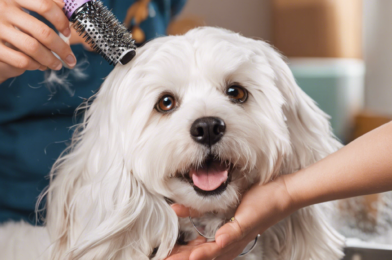Creating a healthy and balanced diet plan for your pet can be a daunting task, especially with the abundance of options and contradicting information available. However, it is an incredibly important aspect of responsible pet ownership, as it directly impacts your furry friend’s health, energy levels, and overall well-being. So, how do you go about crafting a nutritious diet plan that meets your pet’s unique needs?
Firstly, it is essential to recognize that the nutritional requirements vary depending on the species, breed, age, size, and activity level of your pet. A growing puppy or kitten, for instance, has different needs than an adult or senior pet. Similarly, a large breed dog may require a different balance of nutrients than a small breed dog to support their unique growth patterns and maintain a healthy weight. Understanding these specific needs is the first step toward developing a tailored diet plan.
Consulting with a veterinarian or a pet nutritionist is highly recommended. They can provide expert advice and guidance based on your pet’s individual characteristics. These specialists will take into account any health concerns, allergies, or weight management issues your pet may have, and offer tailored recommendations for the types and amounts of food to include in their diet. Regular check-ups with your veterinarian can also help monitor your pet’s health and make adjustments to their diet as needed.
Once you have a better understanding of your pet’s nutritional needs, it’s time to explore the wide world of pet food options. Commercial pet foods are convenient and often specifically formulated to meet the nutritional requirements of different types of pets. However, it’s crucial to read labels and choose high-quality options with whole, natural ingredients. Avoid products loaded with fillers, additives, and artificial ingredients, as these can detract from the nutritional value and may even be harmful to your pet’s health over time.
While commercial pet foods form the basis of your furry friend’s diet, don’t underestimate the power of fresh, whole foods. Incorporating fresh options like lean proteins, complex carbohydrates, and a variety of fruits and vegetables can boost the nutritional content of your pet’s meals. Just be sure to do your research and consult with a veterinarian or nutritionist to ensure you’re providing a balanced mix that meets all their essential nutrient requirements. Certain human foods can be toxic to pets, so it’s important to be well-informed before offering any table scraps or fresh food leftovers.
Treats are another important consideration in your pet’s diet plan. While they shouldn’t make up a significant portion of their calorie intake, treats can be used for training, rewarding good behavior, or simply showing your pet a little extra love. Opt for healthy, natural options, and consider making your own pet treats at home so you know exactly what goes into them. By following these guidelines and working closely with veterinary professionals, you can design a diet plan that keeps your pet healthy, happy, and full of vitality for years to come.
Remember, just as with humans, variety and moderation are key. Offering a diverse array of nutritious foods will ensure your pet gets a well-rounded mix of nutrients, and paying attention to portion sizes will help prevent overeating and maintain a healthy weight. A healthy diet can help your pet maintain a lustrous coat, strong bones and teeth, stable energy levels, and a robust immune system to fight off illnesses. With the right nutritional foundation, you can give your furry companion the best chance at a long and vibrant life.
In addition to a balanced diet, it’s worth noting that adequate hydration is also crucial for your pet’s health. Always provide easy access to fresh, clean water, and be mindful that certain foods or treats may increase your pet’s need for hydration. Regular exercise is another important component of a healthy lifestyle for your furry friend. Ensure your pet gets enough physical activity and mental stimulation to maintain a healthy weight and overall well-being.
Understanding your pet’s specific needs and working closely with veterinary professionals will help you navigate the array of food options and develop a tailored diet plan. While commercial pet foods provide convenience and balanced nutrition, don’t underestimate the benefits of incorporating fresh, whole foods into your pet’s diet as well. By reading labels carefully and opting for high-quality, natural ingredients, you can ensure your furry friend gets all the nutrients they need for a healthy, vibrant life.
In addition to their daily diet, supplements can also play a beneficial role in supporting your pet’s health. However, it’s important to consult with your veterinarian before introducing any new supplements, as they can advise you on which ones are safe and suitable for your pet’s specific needs. Probiotics, for instance, can aid in digestive health and support a healthy gut microbiome, while fish oil supplements can provide a boost of omega-3 fatty acids for joint health and a shiny coat.
While creating a healthy diet plan for your pet may seem challenging at first, it can be a rewarding experience that strengthens the bond you share with your furry companion. By taking the time to understand their unique nutritional needs and showing a commitment to their well-being, you’re setting them up for a happy and healthy future. With the right diet in place, you’ll likely notice improvements in your pet’s energy levels, coat condition, and overall demeanor, proving that your efforts were well worth it.
In summary, a healthy diet plan for your pet should be tailored to their specific needs, taking into account species, breed, age, size, and activity level. Consult with veterinary professionals, read labels carefully, and opt for high-quality, natural ingredients. Provide a variety of fresh, whole foods in addition to commercial pet foods, and don’t forget the importance of hydration and exercise. With these considerations in mind, you’ll be well on your way to giving your furry friend the nutritious foundation they need for a long and vibrant life. A healthy pet is a happy pet!






